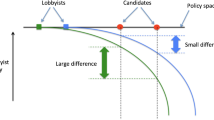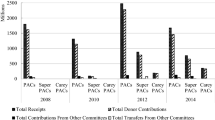Abstract
This paper examines whether campaign contribution restrictions have consequences for election outcomes. States are a natural laboratory to examine this issue. We analyze elections to Assemblies from 1980 to 2001 and determine whether candidates' vote shares are altered by changes in state campaign contribution restrictions. We find that limits on giving narrow the margin of victory of the winning candidate. Limits lead to closer elections for future incumbents, but have less effect on the margin of victory of incumbents who passed the campaign finance legislation. We also find some evidence that contribution limits increase the number of candidates in the race.
Similar content being viewed by others
References
Angrist, J. (1991). Grouped-data estimation and testing in simple labor-supply models. Journal of Econometrics, 47, 243–66.
Ansolabehere, S., de Figueredo, J. M., & Snyder, J. (2003). Why is there so little money in U.S. politics? Journal of Economic Perspectives, 17(1), Winter, 105–130.
Austen-Smith, D. (1987). Interest groups, campaign contributions and probabilistic voting. Public Choice, 54, 123–139.
Bronars, S. G., & Lott, J. R. Jr. (1997). Do campaign donations alter how a politician votes? Or, do donors support candidates who value the same things that they do? Journal of Law and Economics, 40(2), 317–350.
Coate, S. (2004a). Political competition with campaign contributions and informative advertising. Journal of the European Economic Association, 2(5), 772–804.
Coate, S. (2004b). Pareto-improving campaign finance policy. The American Economic Review, 94(3), 628–655.
Feigenbaum, E. D., & Palmer, J. A. (1980–2000). Campaign Finance Law, Federal Election Commission, Bi-Annual Issues.
Gierzynski, A., & Breaux, D. (1991). Money and votes in state legislative election. Legislative Studies Quarterly, 16, 203–217.
Green, D., & Krasno, J. (1988). Salvation of the spendthrift incumbent: Reestimating the effects of campaign spending in House elections. American Journal of Political Science, 32, 363–372.
Grier, K. B. (1989). Campaign spending and senate elections, 1978–1984. Public Choice, 63(3), 201–220.
Grier, K. B., & Munger M. C. (1991). Committee assignments, constituent preferences, and campaign contributions. Economic Inquiry, 29, 24–43.
Gross, D. A., Goidel, R. K., & Shields, T. G. (2002). State campaign finance regulations and electoral competition. American Politics Research, 30(2), 143–165.
Hogan, R. (2000). The Costs of Representation in State Legislatures: Explaining Variations in Campaign Spending, Social Science Quarterly, 81(4), 941–956.
Jacobson, G. (1978). The effects of campaign spending on congressional elections. American Political Science Review, 72, 469–491.
Kettl, D., et al. (1997). Report of the Commission, Vol. I, Governor's Blue-Ribbon Commission on Campaign Finance Reform, State of Wisconsin.
Kousser, T., & LaRaja, R. (2000). How Do Campaign Finance Laws Shape Fundraising Patterns and Electoral Outcomes? Evidence from the States, Working paper.
Kroszner, R. S., & Stratmann, T. (1998). Interest group competition and the organization of congress: Theory and evidence from financial services' political action committees. American Economic Review, 88, 1163–1187.
Levitt, S. (1994). Using repeat challengers to estimate the effect of campaign spending on election outcomes in the U.S. house. Journal of Political Economy, 103, 777–798.
Lott, J. R. (1987). The effect of nontransferable property rights on the efficiency of political markets. Journal of Public Economics, 31(2), 231–246.
Malbin, M. J., & Gais, T. L. (1998). The Day After Reform: Sobering Campaign Finance Lessons from the American States. Rockefeller Institute Press.
Mayer, K. (1998). Public Financing and Electoral Competition in Minnesota and Wisconsin, University of Southern California.
Milyo, J. (1997). The economics of campaign finance: FECA and the puzzle of the not very greedy grandfathers. Public Choice, 93, 245–270.
Milyo, J., Primo, D., & Groseclose, T. (2002). The Effects of State Campaign Finance Regulation on Turnout, Electoral Competition, and Partisan Advantage in Gubernatorial Elections, 1949–1998, Unpublished manuscript.
Milyo, J., & Groseclose, T. (1999). The electoral effects of incumbent wealth. Journal of Law and Economics, 42(2), 699–722.
Mueller, D. C., & Stratmann, T. (1994). Informative and persuasive campaigning. Public Choice, 81(1), 55–77.
Ortuno-Ortin, I., & Schultz, C. (2000). Public Funding for Political Parties, CESifo Working Paper No. 368.
Potters, J., Sloof, R., & van Winden, F. (1997). Campaign expenditures, contributions, and direct endorsements: The strategic use of information and money to influence voter behavior. European Journal of Political Economy, 13, 1–31.
Prat, A. (2002a). Campaign advertising and voter welfare. Review of Economic Studies, 69(4), 999–1017.
Prat, A. (2002b). Campaign spending with office-seeking politicians, rational voters, and multiple lobbies. Journal of Economic Theory, 103(1), 162–189.
Ramsden, G. P. (2002). State legislative campaign finance research: A review essay. State Politics and Policy Quarterly, 2(2), 176–198.
Redfield, K. D. (1995). Cah clout: Political Money in Illinois Legislative Elections. University of Illinois at Springfield.
Redfield, K. D. (2001). Money Counts: How Dollars Dominate Illinois Politics and What We Can Do About It. Institute for Public Affairs, University of Illinois at Springfield.
Snyder, J. M., Jr. (1992). Long-term investing in politicians: Or, give early, give often. Journal of Law and Economics, 35, 15–43.
Smith, B. A. (1995). Campaign Finance Regulation: Faulty Assumptions and Undemocratic Consequences. Cato Policy Analysis, 238.
Stratmann, T. (1991). What do campaign contributions buy? Deciphering causal effects of money and votes. Southern Economic Journal, 57, 606–664.
Stratmann, T. (1992). Are contributions rational? Untangling strategies of political action committees. Journal of Political Economy, 100(3), 647–664.
Stratmann, T. (1995). Campaign contributions and congressional voting: Does the timing of contributions matter? Review of Economics and Statistics, 72(1).
Stratmann, T. (1998). The market for congressional votes: Is the timing of contributions everything? Journal of Law and Economics, 41, 85–114.
Thompson, J. A., & Moncrief, G. F. (eds.) (1998). Campaign Finance in State Legislative Elections. Congressional Quarterly Books.
Wittman, D. (2002). Candidate Quality, Pressure Group Endorsements, and Uninformed Voters, Unpublished manuscript, University of California, Santa Cruz.
Author information
Authors and Affiliations
Rights and permissions
About this article
Cite this article
Stratmann, T., J., F. & Aparicio-Castillo Competition policy for elections: Do campaign contribution limits matter?. Public Choice 127, 177–206 (2006). https://doi.org/10.1007/s11127-006-1252-x
Accepted:
Issue Date:
DOI: https://doi.org/10.1007/s11127-006-1252-x




